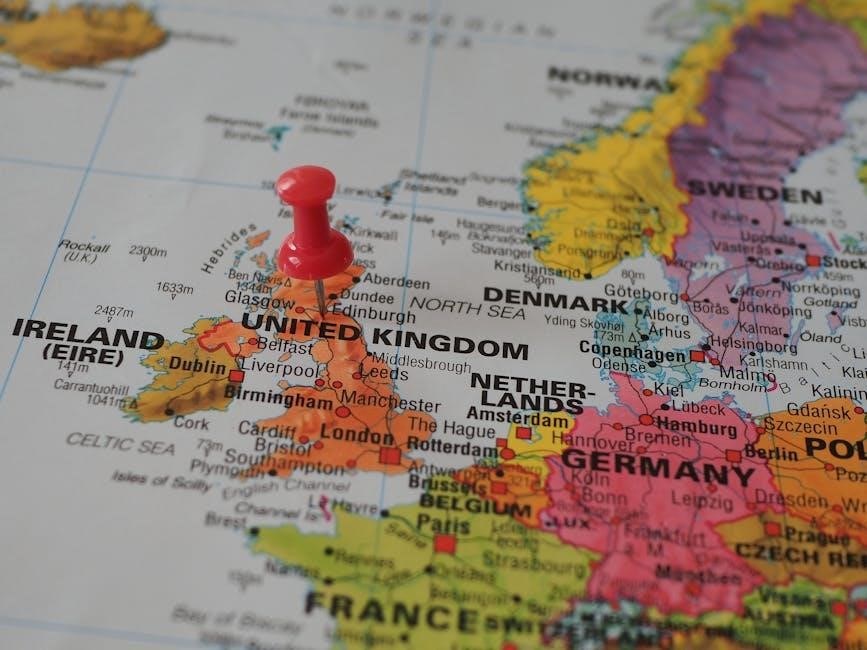
unit 5 revolutions study guide
This unit explores revolutions from 1750 to 1900, focusing on Enlightenment ideas, nationalism, and political change. It covers key events, outcomes, and figures shaping modern history.
1.1 Overview of the Time Period (1750-1900)
The period from 1750 to 1900 was marked by significant revolutions and ideological shifts. It began with the Enlightenment, which challenged traditional authority and inspired movements for democracy and human rights. Major revolutions included the American, French, Haitian, and Latin American wars of independence, as well as the Revolutions of 1848 in Europe. These events were driven by Enlightenment ideas, social inequality, and nationalism, leading to the rise of modern nation-states and the decline of colonial and feudal systems. This era reshaped global politics, society, and culture.
1.2 Significance of Revolutions in World History
Revolutions from 1750 to 1900 reshaped global politics, society, and culture. They challenged traditional authority, promoted democratic ideals, and ended feudal and colonial systems. These movements inspired similar uprisings worldwide, fostering nationalism and self-determination. The spread of Enlightenment ideas, such as natural rights and social contracts, laid the foundation for modern democracy. Revolutions also led to the emergence of independent nation-states and the decline of absolutism. Their legacy continues to influence contemporary political systems and social structures, making this period pivotal in world history.
1.3 Key Themes: Enlightenment, Nationalism, and Political Change
The Enlightenment emphasized reason, individual rights, and challenges to authority, inspiring revolutions. Nationalism emerged as a unifying force, fostering identity and independence movements. Political change shifted power from monarchies to representative systems, ending absolutism. These themes intertwined, driving global transformations and shaping modern nation-states. The period saw the rise of democratic ideals, self-determination, and the decline of colonial rule, leaving a lasting impact on global governance and societal structures.

The Enlightenment and Its Impact
The Enlightenment emphasized reason, individual rights, and challenges to authority, inspiring revolutions. Its ideas spread widely, reshaping political and social structures and fostering democratic ideals globally.

2.1 Key Enlightenment Thinkers: Locke, Rousseau, and Montesquieu
John Locke, Jean-Jacques Rousseau, and Baron de Montesquieu were pivotal Enlightenment thinkers. Locke advocated for natural rights and the social contract, influencing modern democracy. Rousseau emphasized the general will and criticized social inequality. Montesquieu proposed the separation of powers, shaping governance structures. Their ideas revolutionized political thought, inspiring reforms and revolutions across the Atlantic world. These philosophers laid the groundwork for democratic ideals, human rights, and constitutional governments, leaving a lasting legacy on global history and political systems.
2.2 Core Ideas: Natural Rights, Social Contract, and Democracy
Natural rights, such as life, liberty, and property, were seen as inherent to all individuals. The social contract theory posited that governments derive authority from the consent of the governed. Democracy emerged as a system where power resides with the people, often through representation. These ideas challenged traditional authority and absolute rule, inspiring movements for liberty and equality. They laid the foundation for modern governance, emphasizing the protection of individual rights and the accountability of rulers to their citizens, shaping revolutions and political systems globally.
2.3 Spread of Enlightenment Ideas Across Europe and the Americas
Enlightenment ideas spread rapidly through Europe and the Americas via books, pamphlets, and intellectual circles. Thinkers like Locke, Rousseau, and Montesquieu influenced political and social reforms. In the Americas, these ideas fueled the American Revolution, while in Europe, they inspired movements against absolutism. The dissemination of Enlightenment principles laid the groundwork for democratic movements, nationalism, and the reorganization of political systems, shaping the modern world and its governance structures.
The American Revolution (1776)
The American Revolution (1776) marked a pivotal moment in history, driven by Enlightenment ideals. It led to the Declaration of Independence and the formation of the United States, shaping modern democracy and governance.
3.1 Causes: Taxation Without Representation and Colonial Grievances
The American Revolution was driven by colonial grievances, primarily taxation without representation. Laws like the Stamp Act and Townshend Acts imposed taxes on colonies without consent, fueling resentment. Colonists, inspired by Enlightenment ideas of liberty and representation, resisted British authority. Economic hardships and restrictions on westward expansion further strained relations. These issues unified colonies against Britain, laying the groundwork for revolution and the pursuit of independence.
3.2 Key Events: Declaration of Independence and the Revolutionary War
The Declaration of Independence, adopted in 1776, formally declared the colonies’ independence from Britain. Written by Thomas Jefferson, it emphasized natural rights and self-governance. The Revolutionary War began in 1775 with the Battles of Lexington and Concord. Key events included the Continental Army’s resilience under George Washington and the pivotal Battle of Saratoga. The war concluded in 1783 with the Treaty of Paris, recognizing the United States as an independent nation. Foreign alliances, particularly with France, were crucial in securing victory.
3.3 Outcomes: Formation of the United States and Its Constitution
The American Revolution resulted in the formation of the United States as a sovereign nation. The Articles of Confederation initially governed the new country, but they proved inadequate; In 1787, the Constitutional Convention drafted the U.S. Constitution, establishing a federal system with three branches of government. The Constitution enshrined principles of federalism, checks and balances, and individual rights. The Bill of Rights, added in 1791, further protected citizens’ liberties. These developments set a precedent for democratic governance and inspired future revolutions worldwide.
3.4 Key Figures: George Washington, Thomas Jefferson, and Benjamin Franklin
George Washington, as commander-in-chief of the Continental Army, led the colonies to victory and became the first U.S. president, setting crucial precedents. Thomas Jefferson, author of the Declaration of Independence, championed liberty and later served as president. Benjamin Franklin, a diplomat and polymath, secured French support for the Revolution and influenced the Constitution. Their leadership and ideas were instrumental in shaping the United States, leaving a lasting legacy in American and world history.
The French Revolution (1789-1799)
The French Revolution, spanning 1789 to 1799, was a transformative period marked by social unrest, political upheaval, and the collapse of the absolute monarchy, reshaping European history.
4.1 Causes: Financial Crisis, Social Inequality, and Absolutism
The French Revolution was driven by a severe financial crisis, exacerbated by costly wars and an unfair tax system. Social inequality deepened as the nobility and clergy enjoyed privileges while the Third Estate bore the economic burden. Absolute monarchy under Louis XVI further fueled discontent, as Enlightenment ideas challenged such autocratic rule. These factors created widespread frustration, setting the stage for revolutionary change.
4.2 Key Events: Storming of the Bastille, Reign of Terror, and Napoleon’s Rise
The Storming of the Bastille on July 14, 1789, marked the symbolic start of the French Revolution, targeting the monarchy’s oppressive authority. The Reign of Terror (1793–1794), led by Robespierre, saw mass executions of perceived enemies of the revolution. Napoleon Bonaparte’s rise began with his coup in 1799, centralizing power and expanding France’s influence. His leadership transformed Europe politically and militarily, culminating in his self-proclamation as Emperor in 1804, reshaping the continent’s landscape.
4.3 Outcomes: Execution of Louis XVI, Establishment of the First Republic
The execution of Louis XVI in 1793 symbolized the end of absolute monarchy and the monarchy itself. The First Republic was declared in September 1792, marking a radical shift toward republicanism. These events solidified the revolution’s break from the past, leading to a period of political upheaval. The Reign of Terror followed, while Napoleon’s eventual rise transformed France and Europe, leaving a lasting legacy of revolutionary ideals and political restructuring.
4.4 Key Figures: Maximilien Robespierre, Napoleon Bonaparte, and Marie Antoinette
Maximilien Robespierre, a leading figure of the Reign of Terror, championed radical revolutionary ideals but was eventually executed in 1794. Napoleon Bonaparte rose to power, transforming the revolution’s chaos into a military empire. Marie Antoinette, the doomed queen, became a symbol of monarchy’s excess, executed in 1793. These figures shaped the revolution’s trajectory, influencing its violent phases, political restructuring, and lasting legacy in European history.

The Haitian Revolution (1791-1804)
The Haitian Revolution, the largest successful slave revolt, led to Haiti’s independence as the first Black nation. Influenced by Enlightenment ideas, it challenged colonial rule and slavery.

5.1 Causes: Slavery, Racial Inequality, and Enlightenment Ideas
The Haitian Revolution was fueled by the brutal conditions of slavery, deep racial inequality, and the inspiring ideals of the Enlightenment. Enslaved Africans endured harsh treatment on plantations, while racial laws denied them basic rights. Enlightenment concepts of liberty and equality, spread by thinkers like Rousseau, influenced both enslaved and free Black people. These ideas ignited resistance, as enslaved individuals sought freedom and justice, ultimately sparking one of history’s most significant uprisings against colonial oppression and slavery.

5.2 Key Events: Boukman’s Rebellion and the Declaration of Independence
Boukman’s Rebellion in 1791 marked the beginning of the Haitian Revolution, as enslaved Africans, led by Boukman, revolted against French colonial rule. This uprising, sparked by a Vodou ceremony, unified the enslaved population and ignited the fight for freedom. In 1804, Haiti declared its independence, becoming the first independent Black nation in the world. These events symbolized the power of resistance against oppression and the pursuit of liberty, shaping Haiti’s identity and inspiring similar movements globally.
5.3 Outcomes: Haiti as the First Independent Black Nation
The Haitian Revolution culminated in Haiti’s declaration of independence in 1804, establishing it as the world’s first independent Black nation. This outcome dismantled French colonial rule and slavery, inspiring global movements for freedom and equality. Jean-Jacques Dessalines, a key leader, played a pivotal role in solidifying Haiti’s sovereignty. The revolution challenged racial hierarchies and demonstrated the power of collective resistance, leaving a lasting legacy in the fight against oppression and the pursuit of self-determination for marginalized communities worldwide.
5.4 Key Figures: Toussaint Louverture, Jean-Jacques Dessalines, and Boukman
Toussaint Louverture emerged as a charismatic leader, uniting enslaved Haitians and sparking the revolution. Jean-Jacques Dessalines, a former slave, played a pivotal role in declaring Haiti’s independence in 1804. Boukman, a Vodou priest, ignited the uprising with his call for freedom. These figures symbolized resistance against oppression, shaping Haiti’s identity as the first independent Black nation. Their leadership and sacrifices remain central to Haiti’s history and the global struggle for equality and self-determination.

Latin American Revolutions (Early 19th Century)
Latin American Revolutions (Early 19th Century) were sparked by colonial rule and Enlightenment ideas, leading to independence movements and the birth of new nations.
6.1 Causes: Spanish and Portuguese Colonial Rule, Enlightenment Influence
Latin American revolutions were driven by centuries of oppressive Spanish and Portuguese colonial rule, which fostered economic exploitation and social inequality. Enlightenment ideas, emphasizing liberty and equality, inspired colonists to challenge authoritarian regimes. The spread of democratic ideals from Europe and the American Revolution further fueled dissent. Creoles, mestizos, and indigenous peoples sought independence, while leaders like Simón Bolívar and José de San Martín emerged to lead the fight against colonial powers, aiming to establish sovereign nations based on Enlightenment principles.
6.2 Key Events: Wars of Independence Led by Bolivar and San Martin
The Latin American wars of independence were marked by pivotal campaigns led by Simón Bolívar and José de San Martín. Bolívar’s victories in Venezuela, Colombia, and Peru were instrumental in freeing northern regions from Spanish control. San Martín’s successful crossing of the Andes and triumph at the Battle of San Lorenzo secured independence for Argentina and Chile. Their collaborative efforts culminated in the liberation of much of South America, setting the stage for the emergence of independent nations like Mexico, Argentina, and Brazil.
6.3 Outcomes: Independence of Countries Like Mexico, Argentina, and Brazil
The Latin American revolutions resulted in the independence of Mexico, Argentina, and Brazil from colonial rule. These nations established their own governments, though political instability often followed. The end of Spanish and Portuguese dominance allowed for the rise of new nation-states, reshaping the region’s political landscape and fostering cultural identity. This period marked the beginning of a new era of self-governance and nationalism across Latin America, influencing future movements for independence and self-determination.
6.4 Key Figures: Simon Bolivar, Jose de San Martin, and Miguel Hidalgo
Simon Bolivar, known as the “Liberator,” played a central role in freeing Venezuela, Colombia, Ecuador, Bolivia, and Peru from Spanish rule. Jose de San Martin led successful independence movements in Argentina, Chile, and Peru. Miguel Hidalgo initiated Mexico’s struggle for independence with the “Grito de Dolores.” These leaders symbolized the fight for self-governance and nationalism, leaving lasting legacies in Latin America’s history. Their efforts reshaped the region, inspiring future movements for independence and unity.
Revolutions of 1848 (Europe)
Revolutions swept across Europe in 1848, driven by nationalism, liberalism, and economic hardship; Key events included uprisings in France, Germany, Austria, and Italy, leading to political reforms.
7.1 Causes: Nationalism, Liberalism, and Economic Hardship
Nationalism, liberalism, and economic hardship fueled the Revolutions of 1848. Nationalist movements sought independence and unity, while liberalism demanded political reforms and civil liberties. Economic struggles, including unemployment and food shortages, exacerbated tensions. Enlightenment ideas about equality and democracy inspired calls for change. These factors combined to create widespread discontent, leading to uprisings across Europe. The revolutions reflected a desire for self-determination and modern governance, driven by both ideological and material pressures.
7.2 Key Events: Revolts in France, Germany, Austria, and Italy
The Revolutions of 1848 began in France with the February Revolution, toppling the monarchy and establishing the Second Republic. In Germany, the March Revolutions pushed for liberal reforms and unification. Austria faced uprisings in Vienna, leading to Metternich’s resignation and demands for constitutional change. Italy saw revolts against Austrian rule, particularly in Lombardy-Venetia. These events marked a wave of political upheaval across Europe, driven by demands for democracy, nationalism, and social reform. The revolts, though largely unsuccessful, highlighted the growing desire for change.
7.3 Outcomes: Limited Success but Long-Term Impact on Nationalism
Despite the revolutions’ short-term failures, they left a lasting legacy. Many uprisings collapsed, and conservative regimes were restored, but the idea of nationalism persisted. The unification movements in Germany and Italy gained momentum, inspired by the 1848 revolts. National identity became a powerful force, shaping future political movements. Although immediate goals like constitutional reforms were unmet, the revolutions laid the groundwork for eventual unification and the rise of nation-states in Europe, influencing long-term political and social change across the continent.
7.4 Key Figures: Victor Hugo, Giuseppe Garibaldi, and Otto von Bismarck
Victor Hugo, a renowned writer, championed democratic ideals and influenced revolutionary thought. Giuseppe Garibaldi led military campaigns for Italian unification, embodying nationalist spirit; Otto von Bismarck, though conservative, strategically unified Germany, shaping modern nation-states. These figures, despite differing roles, left lasting impacts on nationalism and political change in 19th-century Europe, inspiring future movements and solidifying the importance of national identity in shaping history.
The Role of Nationalism in 19th-Century Revolutions
Nationalism was a powerful force in 19th-century revolutions, unifying groups and inspiring independence movements. It reshaped Europe by creating nation-states and promoting self-determination, blending unity with division.
8.1 Rise of Nationalist Movements Across Europe
Nationalist movements surged in 19th-century Europe, fueled by Enlightenment ideals of equality and self-determination. People began identifying with their cultural and ethnic heritage, demanding self-governance. This shift challenged multi-ethnic empires like the Habsburgs and Ottomans. Nationalism unified groups through shared history and language but also created divisions. Key examples include German unification under Prussian leadership and Italy’s unity under Piedmont. These movements reshaped Europe’s political landscape, emphasizing national identity over imperial rule, and laid the groundwork for future independence struggles across the continent.
8.2 Nationalism as a Unifying and Divisive Force
Nationalism served as both a unifying and divisive force in 19th-century Europe. It united people through shared identity, culture, and history, fostering pride and collective purpose. However, it also created divisions by emphasizing differences between nations, often leading to conflicts. Nationalist movements sometimes excluded minority groups, fueling tensions within multi-ethnic states. This duality shaped political landscapes, inspiring unity in some regions while sowing discord in others, highlighting the complex role of nationalism in shaping modern nation-states.

8.3 Examples: German and Italian Unification
German and Italian unification exemplify nationalism’s impact. Germany unified under Prussian leadership, with Bismarck using diplomacy and wars to create the German Empire by 1871. Italy unified through efforts by Sardinia-Piedmont, supported by Garibaldi and Cavour, achieving independence by 1861. Both processes highlighted nationalism’s power to inspire unity but also revealed challenges, such as integrating diverse regions and addressing political tensions. These movements reshaped Europe’s political landscape, demonstrating how nationalist ideals could drive significant change.

The Legacy of Revolutions (1750-1900)
The revolutions spread democratic ideals, ended feudalism, and inspired nation-states. They reshaped global politics, fostering human rights and self-governance, leaving a lasting impact on modern societies.
9.1 Spread of Democratic Ideals and Human Rights
The revolutions from 1750 to 1900 disseminated democratic ideals and human rights globally. Enlightenment thinkers inspired movements advocating liberty, equality, and justice. The American and French Revolutions championed these principles, influencing other regions. Latin American and Haitian revolutions embraced similar ideals, fighting colonial rule and slavery. Nationalist movements in Europe furthered democratic reforms. These revolutions dismantled feudal systems and absolute monarchies, fostering modern nation-states. The legacy includes the global recognition of human rights and self-determination, shaping contemporary political ideologies and international frameworks.
9.2 End of Feudalism and Absolutism in Europe
The revolutions from 1750 to 1900 led to the decline of feudalism and absolutism in Europe. Enlightenment ideas challenged traditional hierarchies, while political upheavals dismantled feudal systems. The French Revolution particularly targeted noble privileges and absolute monarchy, inspiring similar movements across Europe. Nationalist and liberal reforms further eroded feudal structures, replacing them with modern nation-states. This shift transformed governance, reducing aristocratic power and laying the groundwork for constitutional monarchies and democratic institutions. The end of absolutism marked a significant step toward modern political systems in Europe.
9.3 Emergence of New Nation-States
The revolutions from 1750 to 1900 led to the emergence of new nation-states, reshaping the global political landscape. Nationalist movements and the decline of empires fostered independence and unification. For instance, Germany and Italy unified under nationalist leaders, while Latin American countries broke free from colonial rule. These changes promoted self-determination and sovereignty, laying the foundation for modern nation-states. The rise of democratic ideals further solidified these new political entities, creating a world dominated by nation-states rather than empires or feudal systems.
Study Tips and Resources for Unit 5
Utilize AI-generated flashcards, summaries, and practice tests for effective studying. Access AP World History Unit 5 materials, including reading questions and essay prompts, to excel on exams.
10.1 Flashcards for Key Terms: Enlightenment, Social Contract, Natural Rights
Flashcards are an effective way to master key terms like Enlightenment, Social Contract, and Natural Rights. Define each term, link them to historical context, and include examples. For instance, the Enlightenment emphasized reason and individual rights, inspiring revolutions. The Social Contract, from Rousseau, explained government legitimacy through consent. Natural Rights, championed by Locke, underpinned democratic ideals. Use AI-generated flashcards or create your own to reinforce these concepts, essential for understanding the ideological foundations of 18th- and 19th-century revolutions.

10.2 Practice Questions and Essay Prompts
Engage with practice questions and essay prompts to deepen your understanding of revolutions. Multiple-choice questions test factual knowledge, while short-answer and essay prompts assess analytical skills. Practice writing about causes, key events, and outcomes of revolutions like the American, French, and Haitian. Essay prompts may ask you to compare revolutions or explain the role of Enlightenment ideas. Use these tools to refine your argumentation skills and prepare for exam questions effectively.
10.3 Recommended Reading and Online Resources
Enhance your study with recommended reading and online resources. Utilize the study guide for key terms and events. Explore AI-generated flashcards and summaries for interactive learning. Visit Khan Academy, Crash Course, and Quizlet for additional insights. Access historical texts like The Social Contract and The Declaration of the Rights of Man. Leverage online platforms for practice tests and essay prompts. These resources will help you master Unit 5 content and prepare effectively for exams with a focus on argumentation and historical analysis.